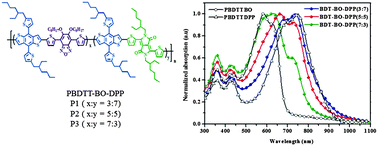We have used Stille coupling polymerization to synthesize a series of new donor–acceptor (D–A) conjugated random copolymers—PBDTT-BO-DPP—that comprise electron-rich alkylthienyl-substituted benzodithiophene (BDTT) units in conjugation with electron-deficient 2,1,3-benzooxadiazole (BO) and diketopyrrolopyrrole (DPP) moieties that have complementary light absorption behavior. These polymers exhibited excellent thermal stability with thermal degrading temperatures higher than 340 °C. Each of these copolymers exhibited (i) broad visible light absorption from 400 to 900 nm and (ii) a low optical band gap that is smaller than 1.4 eV and a low-lying highest occupied molecular orbital that is deeper than −5.22 eV. As a result, bulk heterojunction photovoltaic devices derived from these polymers and fullerenes provided a high short-circuit current density that is larger than 12 mA cm−2. In particular, a photovoltaic device prepared from the PBDTT-BO-DPP (molar ratio, 1 : 0.5 : 0.5)/PC71BM (w/w, 1 : 2) blend system with 1-chloronaphthalene (1 volume%) as an additive exhibited excellent photovoltaic performance, with a value of Voc of 0.73 V, a high short-circuit current density of 17 mA cm−2, a fill factor of 0.55, and a promising power conversion efficiency of 6.8%, indicating that complementary light-absorption random polymer structures have great potential for increasing the photocurrent in bulk heterojunction photovoltaic devices.

You have access to this article
 Please wait while we load your content...
Something went wrong. Try again?
Please wait while we load your content...
Something went wrong. Try again?


 Please wait while we load your content...
Please wait while we load your content...